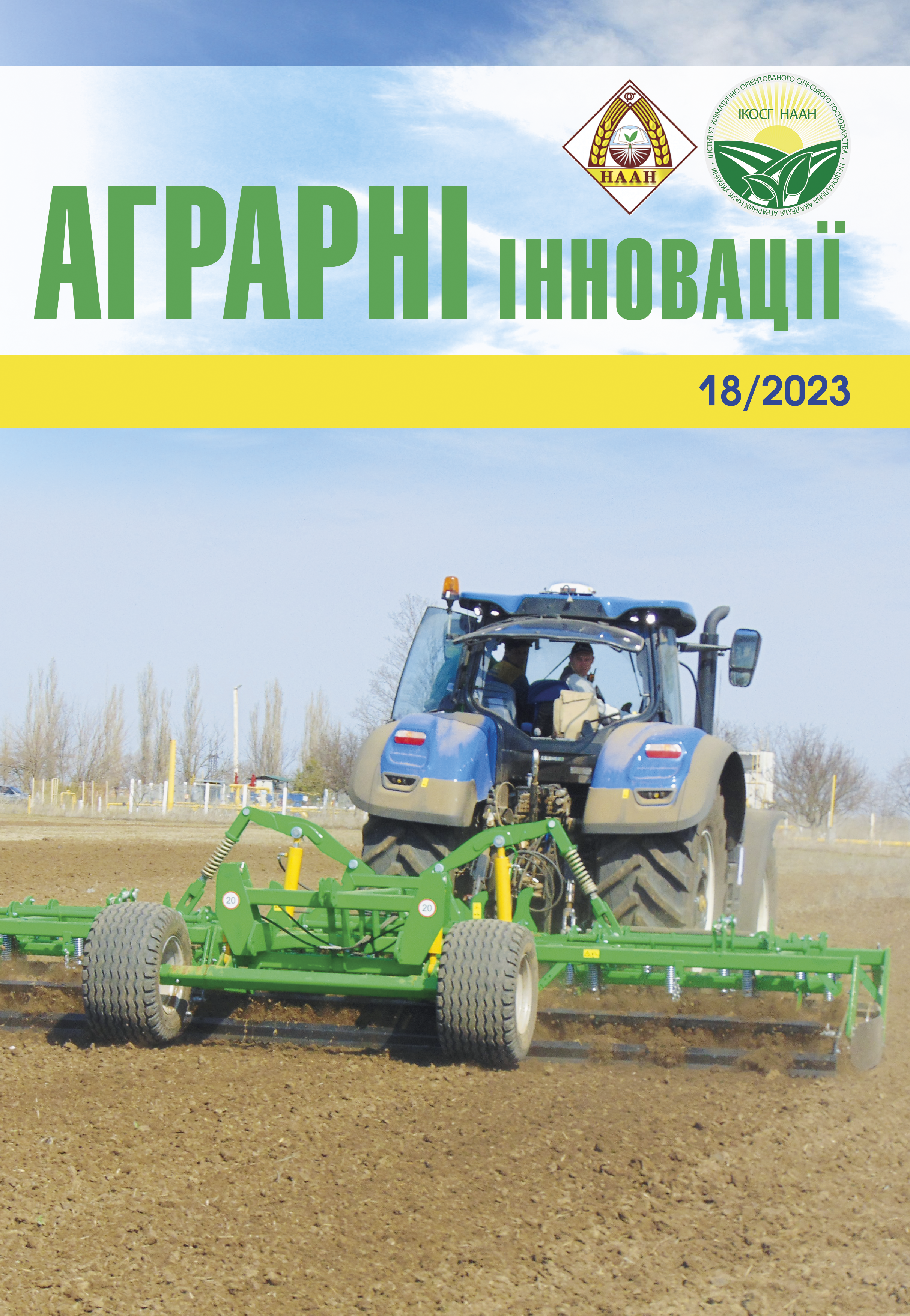STUDY OF THE EFFICIENCY OF GENETIC RESISTANCE SYSTEMS OF DIFFERENT ORIGIN TO LEAF RUST IN THE PROCESS OF BREAD WINTER WHEAT BREEDING
Abstract
The purpose. To investigate the efficiency of different genetic systems of winter bread wheat resistance to leaf rust and the possibility of increasing the resistance of varieties by pyramiding different resistance genes from different genetic systems. Research materials and methods. The material for the study were collection and breeding lines carrying genetic resistance systems in their genotype (Serbia-Odesa (hereinafter LrSO), Lr34, Western Europe (hereinafter LrWE), SIMMIT-ICARDATurkey (hereinafter LrSIT), Phyto (hereinafter LrPh), Wild relatives (Aeg. Cylindrica)" (hereinafter referred to as LrAeCl) and their certain combinations ("Translocation (1BL/1RS) + Lr34+Western Europe" (hereinafter referred to as Lr1BL/1RS+Lr34+WE)). Research methods – field, laboratory, comparison, generalisation, and mathematical statistics –were performed using Excel. Results. After studying the efficiency of genetic resistance systems of different origin to leaf rust, it was found that the most effective systems were "Lr34" and Lr1BL/1RS+Lr34+WE, both in the juvenile period and in the adult phase of the second competitive variety test, according to the average resistance and yield indexes. According to the results of the evaluation of the lines of the first competitive variety test for resistance to leaf rust in different phases of development and yield for two years of research (2021–2022), it was found that two genetic systems were more efficient: LrSO and "Lr34", and a high coefficient of variation of these indicators was observed in all systems that were involved in the experiment, which indicates the possibility of selecting among them representatives with the studied parameters in sufficient quantity. Notably, with an increase in the average resistance in the adult phase of the plant in 2022 compared to 2021, there is a decrease in the average yield and resistance in the juvenile period of plant development. The exceptions are the LrSO and LrPh systems, which showed an increase in the average stability index by representatives in the juvenile period, and the Lr34 system by its stability in the second competitive test. There is also an increase in the average resistance index in the adult phase in 2022 compared to 2021, one of the reasons for this phenomenon is the influence of abiotic factors, in particular moisture and temperature. Conclusions. The most effective systems are "Lr34", which stood out for its average resistance and yield over the years of research, despite the influence of abiotic factors, and maintained high yield stability for two years of research, and the LrWE system, but due to the high coefficient of variation, almost every system has representatives with sufficient and high resistance that can be used in further selection for resistance. There is also an increase in average resistance and a decrease in average yield in 2022 compared to 2021, which can be explained by selection and by the influence of abiotic factors.
References
2. Созінов О.О. Лісова Г. М. Маркери ознаки стійкості проти збудника бурої іржі і шляхи використання їх у селекції. Захист і карантин рослин. 1999. № 45. С. 124–127.
3. Ретьман С.В., Шевчук О.В., Горбачова Н.П., Райчук Л.В. Зернове поле. Захист рослин. 2004. № 10(100). С. 1–3.
4. Ретьман, М.С. Хвороби листя ярої пшениці. Карантин і захист рослин. 2011. № 9. С. 8–9.
5. Дерменко О.П. Панченко Ю.С., Гаврилюк Л.Л. Захист пшениці озимої від бурої листкової іржі. Карантин і захист рослин. 2013. № 5. С. 9–11.
6. Дерменко О.П., Панченко Ю.С., Гаврилюк Л.Л. Небезпечна хвороба пшениці озимої. Бура листкова іржа (Puccinia recondita Rob. ex Desm. f. sp. tritici): поширення і розвиток в Лісостепу України. Карантин і захист рослин 2012. №11. С. 4–7.
7. Agrios, G.N. Plant pathology., 5th edn. Elsevier Academic Press: San Diego. 2005. P. 978.
8. Марков І.Л. Волога проти пшениці: хвороби в умовах зрошення. Агросектор. 2008. № 2 (27). С. 24–25.
9. Трибель С.О., Гетьман М.В., Стригун О.О. та ін. Методологія оцінювання стійкості сортів пшениці проти шкідників і збудників хвороб. 2010. С. 392.
10. Lagudah E.S., Krattinger S.G., Herrera- Foessel S. etal. Gene–specific markers for the wheat gene Lr34/Yr18/Pm38 which confers resistance to multiple fungal pathogens. Theor. Appl. Genetics. 2009. Vol. 119. P. 889–898.
11. Raj K.J., Sanghamitra, N. Gene pyramiding – A broad spectrum technique for developing durable stress resistance in crops. Biotechnology and Molecular Biology Reviews. 2010. № 5(3). С. 51–60.
12. Методика державного сортовипробування сільськогосподарських культур. Зернові, круп’яні та зерно- бобові. Київ, 2001. С. 66.
13. Babayants, O. V., Babayants, L. T. (2014). Fundamentals of selection and methodology for assessing wheat resistance to pathogens. NAAN, Selektsionnogeneticheskiy institut – Natsionalnyiy tsentr semenovedeniya i sortoizucheniya. SGI–NTsSS Odessa: VMV, 182–198.
14. Кірчук Є.І., Алєксєєнко Є.В. Генетичні джерела стійкості пшениці м’якої озимої до бурої іржі та їх цінність в ювенільний період розвитку. Зернові культури. Том 6. № 2. 2022. С. 30–34. DOI: 10.31867/2523-4544/0228
15. Методика проведення експертизи сортів рослин групи зернових, круп’яних та зернобобових на придатність до поширення в Україні. Затверджено Наказом Міністерства аграрної політики та продовольства України 12.12.2016р. № 540.






